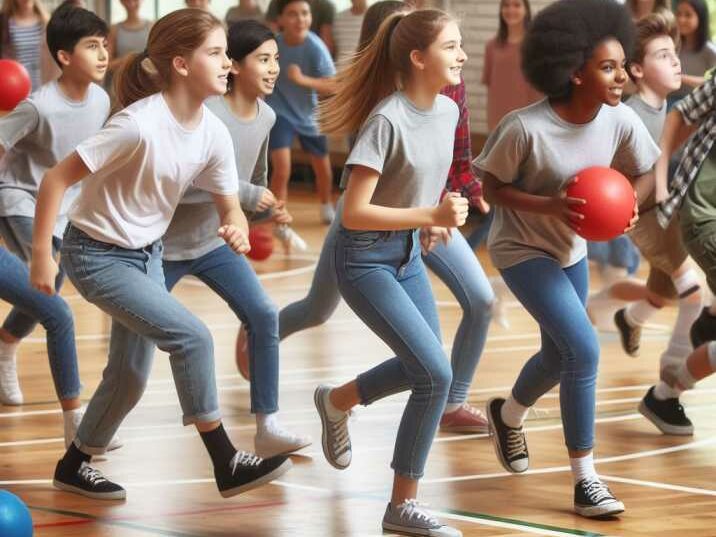Introduction:
Table of Contents
Dodgeball, a game cherished by many, offers more than just entertainment—it presents a plethora of benefits that extend well beyond the playground. In recent years, there has been a growing debate over whether dodgeball should be included in school physical education programs. Despite some controversies surrounding the game, numerous studies and experts advocate for its integration into school curriculums. Let’s delve into the seven compelling reasons why dodgeball should be an essential component of school physical education programs.

Advantages of Incorporating Dodgeball into School Physical Education programs:
1. Promotes Physical Fitness:
Dodgeball isn’t just a game; it’s a fantastic way to keep our bodies healthy and active. When we play dodgeball, our hearts beat faster, and we breathe harder, which is great for our cardiovascular health. Imagine running, jumping, and dodging—all while having a blast with our friends! These movements help us stay fit and improve our overall health.
- Enhancing Cardiovascular Health: Dodgeball’s dynamic gameplay encourages constant movement, boosting heart rate and improving overall cardiovascular health. When we play dodgeball, our hearts work harder, pumping more blood and oxygen to our muscles, which strengthens our heart muscles and keeps our cardiovascular system in top shape.
- Agility and Coordination: Through quick bursts of running, jumping, and dodging, players refine their agility and coordination skills, laying a foundation for lifelong fitness habits. Dodgeball requires us to be quick on our feet and nimble in our movements. By dodging balls and aiming throws, we improve our coordination and balance, skills that are essential for various physical activities and sports.
2. Enhances Teamwork Skills:
Building Bonds Through Dodgeball
Playing dodgeball isn’t just about winning; it’s about working together as a team to achieve our goals. When we play dodgeball, we learn how to communicate with our teammates, support each other, and strategize to outsmart our opponents.
- Strategizing as a Team: Players collaborate to devise offensive and defensive strategies, fostering teamwork and communication. In dodgeball, every player has a role to play, whether it’s throwing balls, protecting teammates, or coordinating attacks. By working together and sharing ideas, we become a stronger and more cohesive team, capable of overcoming any challenge that comes our way.
- Cooperation on the Court: Effective coordination and support among teammates are vital for success, reinforcing the importance of cooperation in achieving common goals. Dodgeball teaches us the value of cooperation and teamwork. We learn to trust our teammates, rely on their support, and contribute our skills to the team’s success. Whether we win or lose, we do it together, knowing that we’re stronger when we work as one.
3. Develops Hand-Eye Coordination:
Precision Play: Mastering Aim and Reflexes
Dodgeball requires precise aiming and quick reflexes, making it an excellent activity for improving hand-eye coordination. Players must accurately throw and catch balls while simultaneously evading incoming projectiles. By honing these skills through regular gameplay, students can enhance their overall motor skills and dexterity.
- Precise Aiming: Dodgeball demands accuracy when throwing balls at opponents or targets, requiring players to focus and aim carefully. By practicing throwing techniques, students refine their hand-eye coordination, learning to judge distances and angles effectively.
- Quick Reflexes: Reacting swiftly to incoming balls is crucial in dodgeball, as players must evade or catch projectiles to stay in the game. This rapid response develops reflexes and enhances coordination between the eyes and hands, improving reaction times and agility.
4. Encourages Sportsmanship and Fair Play:
Ethical Engagement: Upholding Values On and Off the Court
In dodgeball, winning isn’t everything—sportsmanship and fair play are equally emphasized. Players learn to respect their opponents, follow rules, and accept both victory and defeat graciously. These valuable lessons instill integrity and empathy, shaping students into well-rounded individuals both on and off the court.
- Respect for Opponents: Dodgeball promotes respect for opponents, emphasizing fair competition and mutual appreciation for each player’s abilities. Whether in victory or defeat, students learn to acknowledge and honor their adversaries, fostering mutual respect and camaraderie.
- Adherence to Rules: Upholding rules and regulations is essential in dodgeball, teaching students the importance of integrity and adherence to established guidelines. By following rules and accepting referees’ decisions, players cultivate a sense of sportsmanship and learn to play with honor and dignity.
5. Boosts Confidence and Self-Esteem:
Empowering Through Achievement: Building Self-Confidence
Participating in dodgeball cultivates a sense of achievement and self-confidence in students. As they develop their skills and contribute to their team’s success, they gain a newfound belief in their abilities. Additionally, overcoming challenges and setbacks during gameplay instills resilience, further bolstering students’ self-esteem.
- Sense of Achievement: Successfully executing strategies and contributing to team victories instills a sense of accomplishment in players, boosting their self-esteem and confidence. Recognizing their capabilities and achievements in dodgeball fosters a positive self-image and encourages students to push their limits.
- Resilience in Adversity: Facing challenges and setbacks during dodgeball matches teaches students the value of resilience and perseverance. By overcoming obstacles and bouncing back from defeats, players develop inner strength and belief in their ability to overcome future challenges, enhancing their self-esteem and resilience.
6. Provides Stress Relief and Mental Well-Being:
Refreshing Recreation: Rejuvenating Mind and Body
Engaging in physical activity, such as dodgeball, is known to alleviate stress and improve mental well-being. The adrenaline rush and camaraderie experienced during gameplay serve as powerful stress relievers, promoting relaxation and boosting mood. By incorporating dodgeball into school physical education programs, schools can prioritize students’ holistic health and happiness.
- Stress Alleviation: The dynamic and fast-paced nature of dodgeball provides an outlet for pent-up stress and tension, allowing students to release negative energy and unwind. The excitement and intensity of gameplay offer a welcome distraction from academic pressures and daily stressors, promoting mental relaxation and rejuvenation.
- Mood Enhancement: Participating in dodgeball sparks joy and camaraderie among students, fostering a sense of belonging and connection. The shared laughter, teamwork, and friendly competition uplift mood and morale, promoting a positive outlook and enhancing overall mental well-being. By promoting fun and enjoyment, dodgeball contributes to a supportive and vibrant school environment conducive to students’ happiness and mental health.
7. Offers Inclusive and Accessible Fun:
Dodgeball for All: Embracing Diversity and Accessibility
Dodgeball is a game that transcends barriers of age, gender, and ability, making it inclusive and accessible to all students. Unlike some sports that require specialized equipment or extensive training, dodgeball can be enjoyed by anyone with a willingness to participate. By embracing inclusivity, schools can create a supportive environment where every student feels valued and included.
- Age, Gender, and Ability Neutrality: Dodgeball welcomes participants of all ages, genders, and abilities, providing an inclusive platform for diverse students to engage in physical activity and social interaction. Regardless of background or skill level, everyone can join in the fun and experience the thrill of dodgeball, fostering a sense of unity and belonging among students.
- Accessibility and Adaptability: With minimal equipment requirements and flexible gameplay rules, dodgeball is accessible to students from varying socioeconomic backgrounds and physical capabilities. Schools can adapt the game to accommodate students with disabilities or special needs, ensuring that everyone can participate and enjoy the benefits of physical activity. By prioritizing inclusivity, schools foster an environment of acceptance and support, where every student can thrive and succeed.
Table of Information school physical education programs:
| Reason | Description |
|---|---|
| Promotes Physical Fitness | Enhances cardiovascular health through constant movement and agility. |
| Enhances Teamwork Skills | Fosters communication and cooperation among players, applicable beyond the game. |
| Develops Hand-Eye Coordination | Improves precision and reflexes through throwing and catching activities. |
| Encourages Sportsmanship and Fair Play | Emphasizes respect, adherence to rules, and acceptance of outcomes. |
| Boosts Confidence and Self-Esteem | Cultivates a sense of achievement and resilience, contributing to self-confidence. |
| Provides Stress Relief and Mental Well-Being | Alleviates stress and boosts mood through adrenaline and camaraderie. |
| Offers Inclusive and Accessible Fun | Transcends barriers of age, gender, and ability, making it accessible to all students. |
Conclusion:
In conclusion, the benefits of integrating dodgeball into school physical education programs are undeniable. From promoting physical fitness and teamwork to boosting confidence and inclusivity, this classic game has the potential to positively impact students’ lives in numerous ways. By embracing dodgeball as a valuable component of school physical education programs, schools can cultivate healthier, happier, and more resilient individuals prepared to tackle life’s challenges head-on.

FAQs:
- Is dodgeball safe for students to play?
- Yes, when supervised properly and played with appropriate rules and equipment, dodgeball is a safe and enjoyable activity for students.
- Do schools need specialized equipment to incorporate dodgeball into school physical education programs?
- While dedicated dodgeballs are ideal, many schools can use soft foam or rubber balls as alternatives, making the game accessible without requiring specialized equipment.
- How can schools address concerns about dodgeball promoting aggression?
- By emphasizing sportsmanship, fair play, and respectful competition, schools can mitigate concerns about dodgeball promoting aggression and ensure a positive playing environment.
- Are there modifications available to accommodate students with physical disabilities?
- Yes, various modifications and adaptations can be implemented to make dodgeball inclusive for students with physical disabilities, ensuring everyone can participate and enjoy the game.
- Can dodgeball be played indoors and outdoors?
- Yes, dodgeball can be adapted to both indoor and outdoor environments, providing flexibility for schools to incorporate it into their PE programs regardless of weather conditions.


